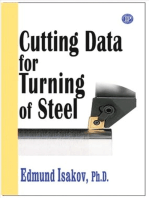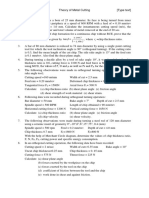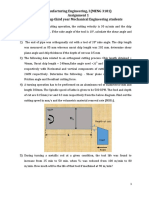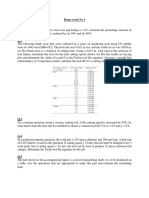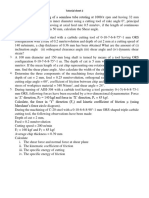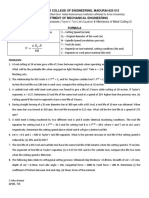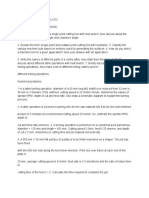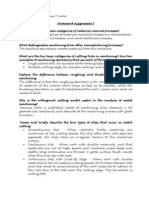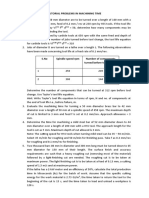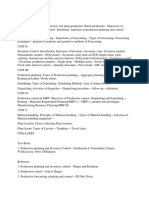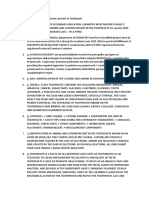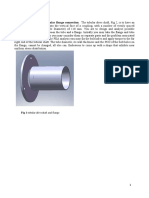0 ratings0% found this document useful (0 votes)
13 viewsCos Tan Here Is The Chip T 1 Si Hickness Ratio. N: R R R W
Cos Tan Here Is The Chip T 1 Si Hickness Ratio. N: R R R W
Uploaded by
pmagrawalThe document discusses chip formation geometry and shear plane angle calculations. It provides equations to calculate the shear plane angle based on the chip thickness ratio and tool rake angle. It then provides multiple examples applying these calculations to determine values like shear plane angle, cutting forces, friction angle, material removal rate, and power requirements for different turning operations using various materials, depths of cut, feeds, and cutting speeds. It also includes examples calculating tool life and determining the optimal cutting speed and tool choice to minimize costs based on tool life equations.
Copyright:
© All Rights Reserved
Available Formats
Download as PDF, TXT or read online from Scribd
Cos Tan Here Is The Chip T 1 Si Hickness Ratio. N: R R R W
Cos Tan Here Is The Chip T 1 Si Hickness Ratio. N: R R R W
Uploaded by
pmagrawal0 ratings0% found this document useful (0 votes)
13 views1 pageThe document discusses chip formation geometry and shear plane angle calculations. It provides equations to calculate the shear plane angle based on the chip thickness ratio and tool rake angle. It then provides multiple examples applying these calculations to determine values like shear plane angle, cutting forces, friction angle, material removal rate, and power requirements for different turning operations using various materials, depths of cut, feeds, and cutting speeds. It also includes examples calculating tool life and determining the optimal cutting speed and tool choice to minimize costs based on tool life equations.
Original Description:
Theory of Metal Cutting
Original Title
PT_QP (Final Yr)
Copyright
© © All Rights Reserved
Available Formats
PDF, TXT or read online from Scribd
Share this document
Did you find this document useful?
Is this content inappropriate?
The document discusses chip formation geometry and shear plane angle calculations. It provides equations to calculate the shear plane angle based on the chip thickness ratio and tool rake angle. It then provides multiple examples applying these calculations to determine values like shear plane angle, cutting forces, friction angle, material removal rate, and power requirements for different turning operations using various materials, depths of cut, feeds, and cutting speeds. It also includes examples calculating tool life and determining the optimal cutting speed and tool choice to minimize costs based on tool life equations.
Copyright:
© All Rights Reserved
Available Formats
Download as PDF, TXT or read online from Scribd
Download as pdf or txt
0 ratings0% found this document useful (0 votes)
13 views1 pageCos Tan Here Is The Chip T 1 Si Hickness Ratio. N: R R R W
Cos Tan Here Is The Chip T 1 Si Hickness Ratio. N: R R R W
Uploaded by
pmagrawalThe document discusses chip formation geometry and shear plane angle calculations. It provides equations to calculate the shear plane angle based on the chip thickness ratio and tool rake angle. It then provides multiple examples applying these calculations to determine values like shear plane angle, cutting forces, friction angle, material removal rate, and power requirements for different turning operations using various materials, depths of cut, feeds, and cutting speeds. It also includes examples calculating tool life and determining the optimal cutting speed and tool choice to minimize costs based on tool life equations.
Copyright:
© All Rights Reserved
Available Formats
Download as PDF, TXT or read online from Scribd
Download as pdf or txt
You are on page 1of 1
From the geometry of chip formation for a continuous type chip without built-up
edge, show that the shear plane angle is given by
r cos
tan c
where rc is the chip thickness ratio.
1 rc sin
State the assumptions made.
During orthogonal turning of a ductile alloy bar by a tool of side rake angle 15,
depth of cut 4.0 mm, feed 0.25 mm/rev, it was found that cutting force is 800 N
and feed force is 500 N. If chip thickness ratio is 0.4, evaluate using Merchant
Circle Diagram (Graphical method):
i. Magnitude of the resultant force
ii. the shear plane angle
iii. the frictional force
iv. the friction angle
C-40 steel is turned with a HSS tool of side rake angle of 8 at a cutting speed of
0.6 m/sec. The depth of cut (chip width) is 1.5 mm whereas the uncut chip
thickness is 0.3 mm. One meter long chip weighs 5.7 g. Assume that the width
of the chip remains unchanged and the metal density is 7.9 g/cm3. Calculate
i. Chip thickness ratio and shear angle.
ii. MRR and power requirement.
It is required to reduce 50 mm dia MS bar to 40 mm dia for 150 mm of length by
means of single operation on a lathe. The conditions are as follows.
Operators hourly rate = Rs. 60
Machine hourly rate = Rs. 240
Time to remove, replace and reset the tool = 0.1 10 min
Cost of regrinding the tool = Rs. 20
Initial cost of tool = Rs. 200
No. of possible regrinds of the tool = 10
No. of parts to be turned = 12000
Feed rate f = 0.2 mm/rev
Taylors Tool life equation VT 0.2 = 300
Evaluate the economic spindle speed for the lathe for minimum cost.
The life of two tools, A and B, are governed by the equations VT 0.125 2.5 and
VT 0.25 7 respectively in certain machining operation where V is the cutting
speed in m/sec and T is tool life in seconds.
(i) Find out the speed at which both the tools will have the same life. Also
calculate the corresponding tool life.
(ii) If you have to machine at a cutting speed of 1 m/sec, then which one of
these tools will you choose in order to have less frequent tool changes?
1 of 2
You might also like
- Tool Life NumericalsDocument2 pagesTool Life Numericalspmagrawal75% (4)
- Assignment: Q.N.1. in A Turning Operation, It Was Observed That The Tool Life Was 150 Minutes When The CuttingDocument7 pagesAssignment: Q.N.1. in A Turning Operation, It Was Observed That The Tool Life Was 150 Minutes When The CuttingAnkesh KapilNo ratings yet
- Tutorial - Metal Removal ProcessDocument2 pagesTutorial - Metal Removal ProcessbananaNo ratings yet
- Theory of Metal Cutting - NumericalsDocument2 pagesTheory of Metal Cutting - Numericalspmagrawal100% (1)
- Assign 1 2012Document2 pagesAssign 1 2012chiru1431No ratings yet
- Assignment 6Document5 pagesAssignment 6Anonymous G6QkwTykKNo ratings yet
- 2 Numericals Bank MP II PDFDocument7 pages2 Numericals Bank MP II PDFThenarasumohanveluNo ratings yet
- SheetDocument4 pagesSheetsherifabdelbassetNo ratings yet
- Mem603 QBDocument11 pagesMem603 QBAman SinghNo ratings yet
- Cutting Force Thrust ForceDocument1 pageCutting Force Thrust ForcepmagrawalNo ratings yet
- Theory of Metal Cutting Numericals PDFDocument2 pagesTheory of Metal Cutting Numericals PDFsanjayNo ratings yet
- TA202 AssignmentsDocument1 pageTA202 AssignmentsBrajesh kumarNo ratings yet
- AssignmentDocument2 pagesAssignmentgirma workuNo ratings yet
- ME 338 Manufacturing Processes II HW#2Document2 pagesME 338 Manufacturing Processes II HW#2Anonymous 2xjDjAcZNo ratings yet
- Solution To Taylors Tool Life ProblemsDocument1 pageSolution To Taylors Tool Life Problems19G133 VASANTH B100% (1)
- Manufacturing Engineering Assignment Thapar UniversityDocument5 pagesManufacturing Engineering Assignment Thapar UniversitySaurav Kumar0% (1)
- AssignmentDocument2 pagesAssignmentgirma workuNo ratings yet
- Exercises 4_solutionsDocument14 pagesExercises 4_solutionsdasagapadelNo ratings yet
- Assignment 1 2Document2 pagesAssignment 1 2Jeevan GNo ratings yet
- EMMU 7244-Machine Tool Vibrations and Cutting Dynamics-Exam July 2016Document4 pagesEMMU 7244-Machine Tool Vibrations and Cutting Dynamics-Exam July 2016Charles OndiekiNo ratings yet
- DOPT AssignmentDocument6 pagesDOPT AssignmentRabindra Kumar LakraNo ratings yet
- Winsem2015 16 Cp0409 20 Jan 2016 Rm01 Amt Unit I Question BankDocument5 pagesWinsem2015 16 Cp0409 20 Jan 2016 Rm01 Amt Unit I Question BankAnit JainNo ratings yet
- EMMU 7244-Machine Tool Vibrations and Cutting Dynamics-Exam July 2016Document4 pagesEMMU 7244-Machine Tool Vibrations and Cutting Dynamics-Exam July 2016Charles OndiekiNo ratings yet
- Home Work No 3Document2 pagesHome Work No 3HarishNo ratings yet
- 414 TutorialsDocument2 pages414 TutorialsAMOS SIFUNANo ratings yet
- Sheets - Sep 2013Document13 pagesSheets - Sep 2013Mohamed OsamaNo ratings yet
- ASSIGNMENT-1 Manufacturing Processes (Metal Cutting)-1Document2 pagesASSIGNMENT-1 Manufacturing Processes (Metal Cutting)-1palamanhariNo ratings yet
- Question Bank For Machining and MetrologyDocument7 pagesQuestion Bank For Machining and MetrologyAbhisheak DineshNo ratings yet
- Ko Wa QuestionDocument6 pagesKo Wa QuestionnyasetiaarnoldNo ratings yet
- MC&TDDocument4 pagesMC&TDGopal Krishan0% (1)
- Problem Set 2Document1 pageProblem Set 2shivam ojhaNo ratings yet
- Exercise 1Document4 pagesExercise 1Rekawt RashedNo ratings yet
- Mechanical Engineering DepartmentDocument2 pagesMechanical Engineering DepartmentArjit Goswami100% (1)
- MP-1 Tut SheetDocument11 pagesMP-1 Tut SheetAnkur ChelseafcNo ratings yet
- 02 Taylors Tool Life Problems UpdatedDocument2 pages02 Taylors Tool Life Problems Updated19G133 VASANTH B100% (1)
- Machining Processes - QuestionDocument2 pagesMachining Processes - QuestionYih Lin ChenNo ratings yet
- Ece TutorialDocument7 pagesEce TutorialShreeji EnggNo ratings yet
- MMM imp quesDocument3 pagesMMM imp quesHarish PanjagalaNo ratings yet
- UTA026 Manufacturing Processes Work SheetDocument3 pagesUTA026 Manufacturing Processes Work SheetGUNJAN KHULLARNo ratings yet
- Metal Cutting 1: N 0.5 N 1 N 1 N 0.5Document6 pagesMetal Cutting 1: N 0.5 N 1 N 1 N 0.5Gangadhar TallaNo ratings yet
- Lect 8Document13 pagesLect 8shashankmay18No ratings yet
- SheetDocument5 pagesSheetsherifabdelbassetNo ratings yet
- Problems Sheet Machine Tools 2015 16Document9 pagesProblems Sheet Machine Tools 2015 16Shafiq AhmadNo ratings yet
- Solution: (a) N = v/πD = 70,000 mm/80 = 279 rev/minDocument11 pagesSolution: (a) N = v/πD = 70,000 mm/80 = 279 rev/minwoihoNo ratings yet
- Man ProDocument2 pagesMan ProlividiveNo ratings yet
- Deber 1Document15 pagesDeber 1jmgavilanes0% (1)
- Me 014Document2 pagesMe 014Jimmy JindalNo ratings yet
- HW 7Document2 pagesHW 7Sean KleinschmidtNo ratings yet
- Assignment No1Document2 pagesAssignment No1netkap17No ratings yet
- Tutorial Problems in Machining TimeDocument2 pagesTutorial Problems in Machining TimeDHANASEKAR K IV A 9023No ratings yet
- انتاج ٢Document9 pagesانتاج ٢khaledfarrag281No ratings yet
- Assignment No1Document2 pagesAssignment No1Thakur Kali DassNo ratings yet
- ME 338 Manufacturing Processes II HW#1Document3 pagesME 338 Manufacturing Processes II HW#1jambu99No ratings yet
- Problem Sheet Metal Machining and Cutting Conditions 2016Document3 pagesProblem Sheet Metal Machining and Cutting Conditions 2016Muhammad imranNo ratings yet
- Question Bank - All UnitsDocument11 pagesQuestion Bank - All UnitsParamasivam Veerappan100% (1)
- Kertas Penerangan 2Document35 pagesKertas Penerangan 2zamreeharunNo ratings yet
- Theory of Metal Cutting, Metal FormingDocument181 pagesTheory of Metal Cutting, Metal Formingprabhjotbhangal100% (1)
- ME3201Document4 pagesME3201Md. Tariqul Islam MunnaNo ratings yet
- Pom IeDocument5 pagesPom IepmagrawalNo ratings yet
- Creo SuppliersDocument1 pageCreo SupplierspmagrawalNo ratings yet
- 3D GeometryDocument3 pages3D Geometrypmagrawal100% (1)
- 1 BmeDocument44 pages1 BmepmagrawalNo ratings yet
- Manufacturing ProcessesDocument2 pagesManufacturing ProcessespmagrawalNo ratings yet
- 3D GeometryDocument3 pages3D GeometrypmagrawalNo ratings yet
- Vibration AnalysisDocument17 pagesVibration AnalysispmagrawalNo ratings yet
- Unit No. Topics Teaching HoursDocument1 pageUnit No. Topics Teaching HourspmagrawalNo ratings yet
- Ma 2264 NM Eee Q.BDocument26 pagesMa 2264 NM Eee Q.BpmagrawalNo ratings yet
- Commonly Used For:: CartesianDocument9 pagesCommonly Used For:: CartesianpmagrawalNo ratings yet
- Standard Error of The EstimateDocument3 pagesStandard Error of The EstimatepmagrawalNo ratings yet
- Robot SensorsDocument1 pageRobot SensorspmagrawalNo ratings yet
- Identification of Cations and Anions Present in ToothpasteDocument4 pagesIdentification of Cations and Anions Present in ToothpastepmagrawalNo ratings yet
- Fem QuestionsDocument1 pageFem QuestionspmagrawalNo ratings yet
- Asrs - FMSDocument2 pagesAsrs - FMSpmagrawalNo ratings yet
- Manual Process PlanningDocument1 pageManual Process PlanningpmagrawalNo ratings yet
- Topics For Active Learning AssignmentDocument1 pageTopics For Active Learning AssignmentpmagrawalNo ratings yet
- Triac VMCDocument20 pagesTriac VMCpmagrawalNo ratings yet
- FDiff Cubic 2nd DerivDocument1 pageFDiff Cubic 2nd DerivpmagrawalNo ratings yet
- Greek Alphabet: Capital Lower-Case Greek Name EnglishDocument1 pageGreek Alphabet: Capital Lower-Case Greek Name EnglishpmagrawalNo ratings yet
- Tubular Driveshaft and FlangeDocument1 pageTubular Driveshaft and FlangepmagrawalNo ratings yet
- Adaptive MeshingDocument1 pageAdaptive MeshingpmagrawalNo ratings yet

